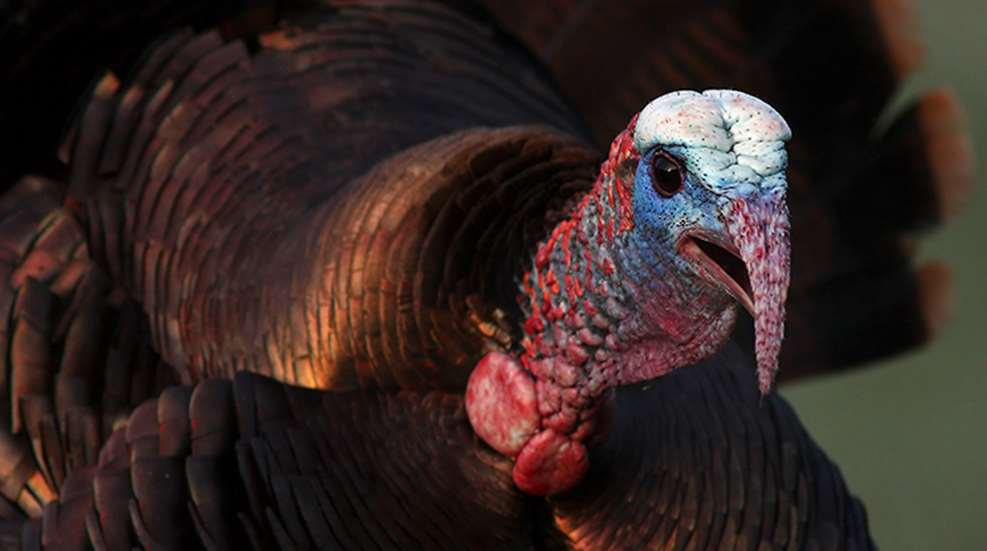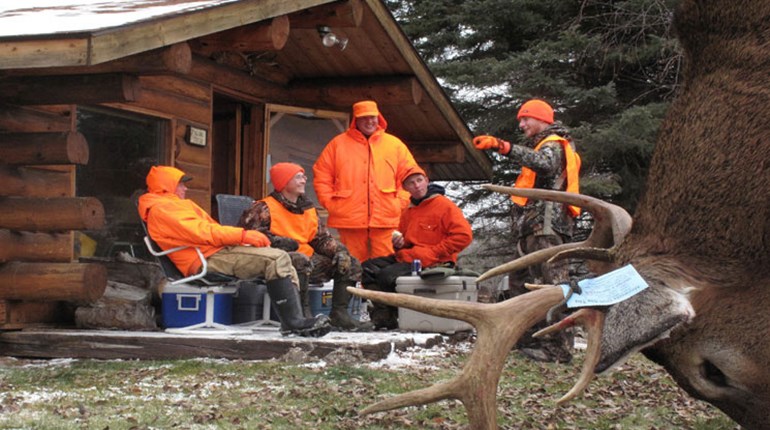
I felt stupid, but then maybe this was stupid-smart—hard to know in the drowsy, dreamy state of another morning begun at 4 a.m. turning to 10 a.m. broken only by the hyper-annoying, high-pitched chime of mosquitoes ringing in my ears. I sprayed on another coat of DEET and tasted it seeping into the corners of my mouth, mingling with sweat. Yeah, the mid-May morning was sticky hot. The trees on the mountainside were all leafed out in fresh green but not even the slightest breeze was shuddering them. I shifted position again. After five hours the cushy “turkey seat” under me was feeling like a seat in coach on a flight to Johannesburg.
I was sitting in a pinch-point with cliffs above and thickets below, and this old villain of a gobbler’s favorite habitat opening like an hourglass behind and in front of me. He’d gobbled from in front of me at first light. I’d heard hens with him then, but they should be leaving him to go to nest and lay an egg each morning now. This old tom liked to strut and gobble in meadows behind me in late morning.
That part of the plan felt smart. But trying to think like a birdbrain gobbler always leaves me feeling stupid—of their natures, and because it’s always critical not to overthink. So the first gobble came as a wonderful shock. I sat up. He was maybe 100 yards in front of me, and lonely. I thought to call, then really called myself stupid. That old bird, a turkey that had beaten me the whole season before and the better part of this one, was coming, no doubt about it. Calling would be saying, “Here I am.” He’d stop. He’d gobble his head off, sure, but it’d be heckling, not real excited gobbling.
Minutes later he was there at 30 yards just walking along all tall and regal, if a thing as goofy as a turkey can be regal. I felt like I was looking at a ghost. I would have had any normal gobbler a few times already, but this bird had this habit of quietly using his head like a submarine’s periscope to look from just over a rise and out of range. Decoys wouldn’t even convince him to commit.
This time, when he saw my gun move, he stretched his neck and looked surprised for the split-second before the shot rolled him down the mountainside.
He was long, but not fat as turkeys down in the farmlands often are. He was a mountain gobbler, and the place immediately felt empty without him. That was his revenge. As I picked him up I knew that waiting on a gobbler’s timetable can feel stupid—the fun part of turkey hunting is the active chess match. But when you have one patterned it can be stupid-smart.
Here are 10 more stupid-smart turkey tactics that work when the time is right.
1. Run Away
When a gobbler is a loudmouth but just won’t come to you, there is likely either an obstacle between you and the bird that he won’t cross or, more likely, he has hens. If he has hens the sage advice is to try to call them in by obnoxiously repeating whatever the dominant hen says. If that doesn’t work, back out and wait until the gobbler is alone. A few gobblers are loudmouths yet know not to come in even when they are not with hens. These vociferous fiends can fall for a “hard-to-get” tactic.
After fruitless mornings of calling only to hear a tom gobble, yet never come, I retreated down a logging road, stopping to call every 50 yards or so. I then slipped back 100 yards and waited. Sure enough, he was trailing me. The last call he heard was me putting to stop him.
Will Primos, founder of Primos Hunting Calls, gave me another example of how distance can add to realism. “One stupid-smart turkey tactic, if you will, is to run from a hot tom on the limb,” he said. “At first light, rather than going to a roosted gobbling turkey, I go away from him and try to get 200-300 yards away. I do this because sometimes when you are within 100 yards the gobbler just gets suspicious and will not come. If you tree-call that close, he knows that hen is on the ground and she ain’t supposed to be. If I do end up within 100 yards, the only sound I will make until the gobbler is on the ground is of a hen landing on the ground. I do that with a wing.”
2. Crawl to Them
The gobblers were just over a gently rolling cow pasture in Missouri. Who crawls down an overgrazed cow pasture at strutting gobblers, especially a pasture covered in cow piles? I do.
The gobblers weren’t coming to me. After an hour, I slowly went to them by pushing the gun out front and slithering. I still remember seeing their red heads between cow piles. The range was close. The shotgun nearly took off the bird’s head. Some hunters will give me a hard time for doing that, but it (and other crawls I’ve done) was one of the most exciting turkey hunts of my life.
The only thing better, and a lot smarter, is crawling in with a gobbler’s outstretched fan in front of you. It is surprising how well this works. Be careful of other hunters, of course. Personally, I wouldn’t do this in the few states that allow turkey hunting with a rifle. But, it can work anywhere on a hung-up or henned-up tom.
3. Sleep with the Enemy
I’ve never spent the whole night snoozing under a roost, but I have slipped in hours before light, rested my back against a tree and dozed until sunrise to get the drop on a hard-to-kill gobbler.
Getting away with this depends on a few things. If they suspect you are there, turkeys won’t fly down at your feet but will fly away. I’ve slipped into roosts crazy-early and thought I was so smart. Before full light the tom gobbled as he always did, but at fly-down time he took off over the trees and landed 100 yards out into a field, which left me feeling pretty stupid. He knew something wasn’t right below his roost. You can’t just walk in under the cover of darkness and sit down and expect them to forget about you. You need a moonless night and a quiet approach.
4. Bring a Lounge Chair
Cutting and running is fun, but when it gets hot mid-morning and you begin to slow down, it’s easy to quit. Instead, grab a chair and have a seat where you’ve heard gobbling late in the morning. Primos’ Wingman Chair is far more comfortable than resting against a tree; it also psychologically roots you in place. Call softly, and scratch the leaves. Pressured or subdominant birds might slip in.
5. Bump a Tom
Sometimes in mid-season you just can’t strike a bird, but you know they’re there. They might be henned up. They are likely call-shy. It might be time to “bump” a turkey. This is stupid if you want to keep hunting a certain place, but if you have a place to burn or your season is winding down this can be stupid-smart.
Slip into a spot where birds are located. Don’t just march around; you likely won’t even know when you’ve bumped birds. Still-hunt for birds. You’ll likely see them trotting away. Stop. Don’t call. Back out and circle. They’ll probably stop a few hundred yards away. Use terrain to get around them. Move in quietly. Set up and call. This has worked for me many times.
6. Surround Them
Typically, two hunters work well when one hangs back and calls, and the other ambushes the gobbler as he makes his way to the call. But when you’re dealing with pressured birds that gobble then walk away from your call, sometimes a new twist is stupid-smart.
Before light, station one hunter where the gobbler went when he made his previous departure from the call (this person won’t call). The caller should set up in the same place he did before. If the tom is lonely and comes to the call, great. If not, there is a good chance the silent partner will be in the perfect place to get him.
7. Just Leave
It can feel stupid to leave a gobbling tom, but sometimes it’s the smartest thing to do. If the bird is hung-up or has hens there is no reason to let him hear all your calls. Next time set up without that obstacle between you, or wait to catch him without hens.
8. Sleep In
This is everyone’s favorite; I feel guilty every time I do it. In mid-season—depending on the timing of the breeding cycle, which depends on the weather—gobblers are often henned-up early, but lose their hens by mid-morning. At a certain point in the cycle hens will leave their gobbler each morning to lay eggs. When they’re done laying eggs they’ll sit on the nest full-time. This incubation helps the eggs all hatch at about the same time. Because of this, it’s easier to call in a dominant tom later in the morning when he’s lonely.
9. Crash the Party
Sometimes bumping a roost—a fall tactic—is just what you need to get a smart, old bird. At sunset most gobblers will gobble a few times from the roost. Use a locater call to prompt them. Wait until almost full dark then walk in and make them fly. Come morning they will be scattered and much calmer than if you bumped them at dawn. Get as close as you can to the tom before he flies down. Mimic a fly-down with a turkey wing, maybe a hat, then call a little. If one of his hens doesn’t get to him first, he’ll likely come right to you.
10. Make some Noise
When all else fails, it can pay to go big. Sometimes you can get a gobbler so worked up with aggressive calling he’ll believe someone who lies so boldly and so loudly might not be fibbing after all. At times I’ve used several calls to create a cacophony of sounds: yelps, gobbles, cutting. I keep it up in a place where I’ve heard gobblers in, say, mid- to late morning. In my experience, the gobblers that fall for this will sneak in, as if they’re wondering who’s throwing a party and whether they can crash it.




































